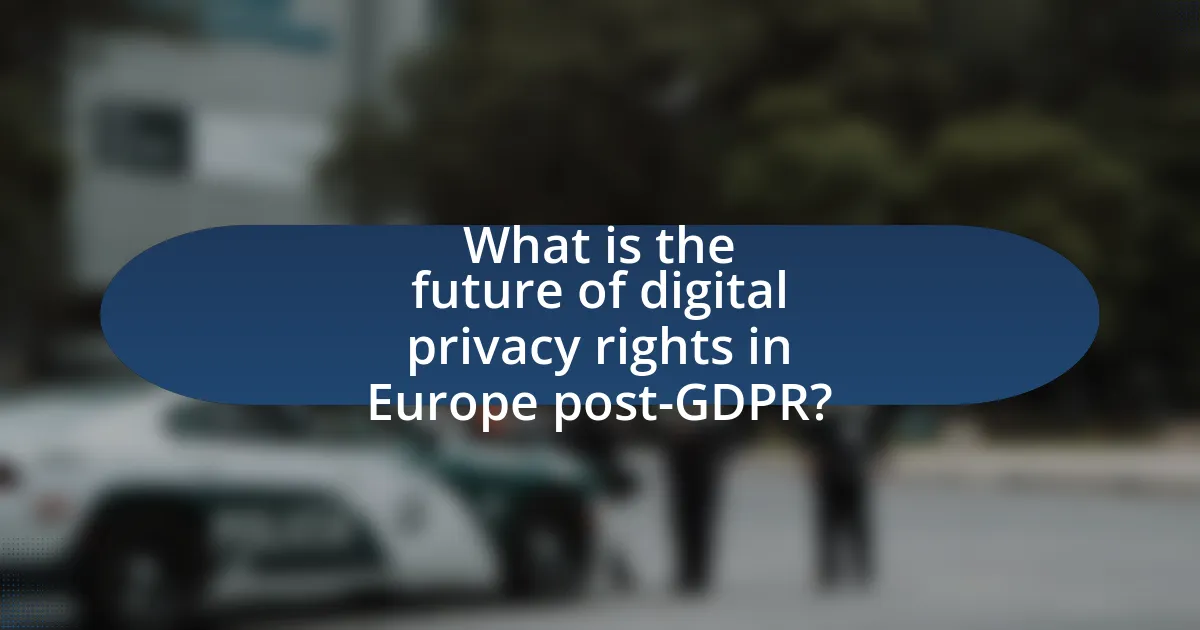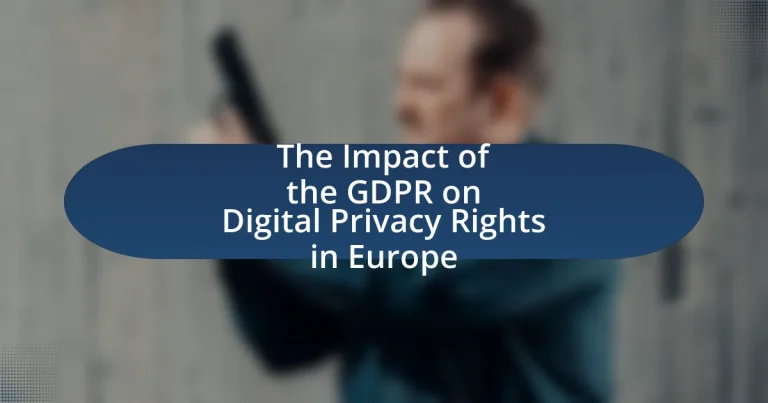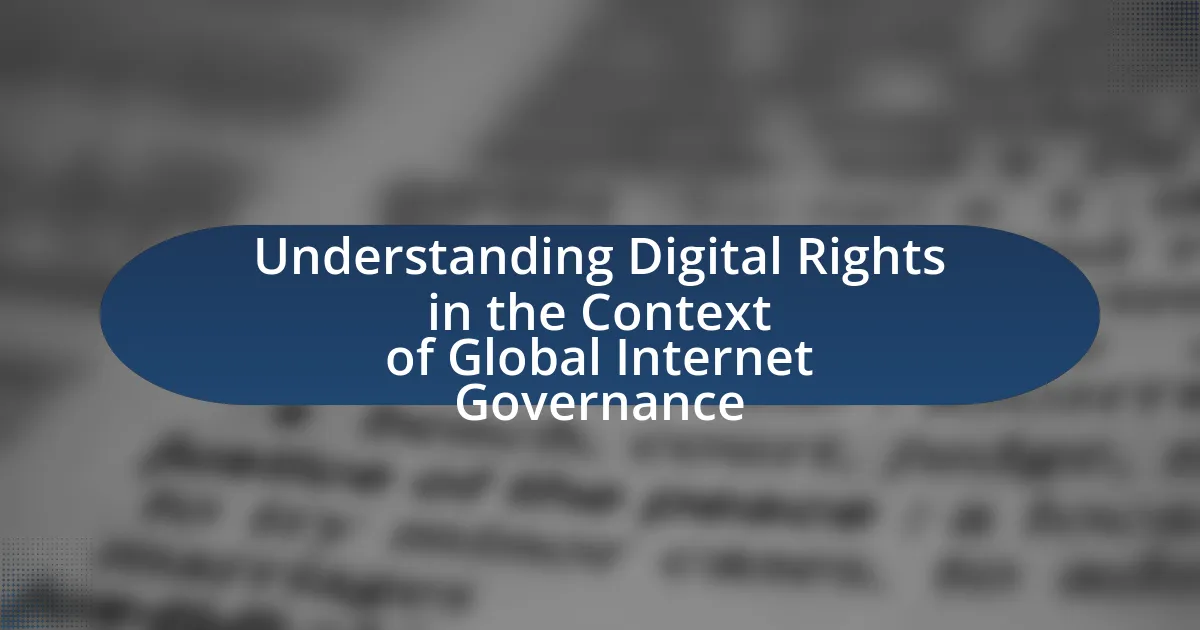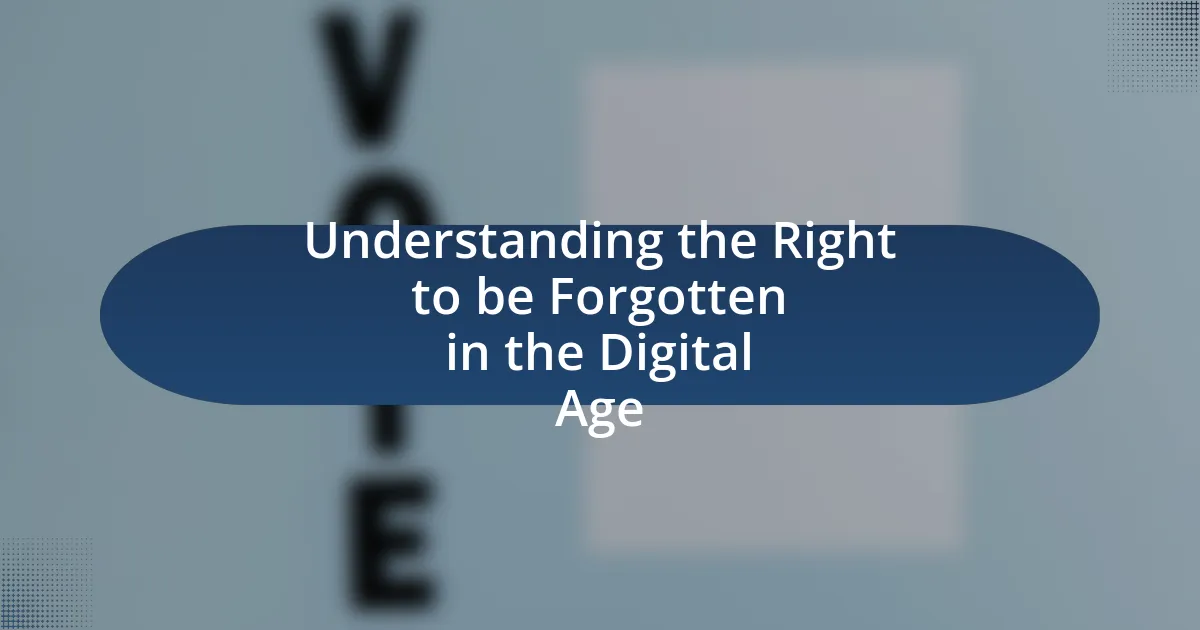The General Data Protection Regulation (GDPR) is a pivotal data protection law enacted by the European Union in May 2018, designed to enhance individuals’ control over their personal data and establish stringent guidelines for data handling. This article examines the significance of the GDPR for digital privacy rights in Europe, detailing its broad definition of personal data, key principles such as consent and accountability, and the rights it grants individuals, including access and erasure. Additionally, it discusses the implications of GDPR compliance for businesses, the challenges posed by technological advancements, and the future of digital privacy rights in Europe as the regulation adapts to emerging technologies.

What is the GDPR and its significance for digital privacy rights in Europe?
The General Data Protection Regulation (GDPR) is a comprehensive data protection law enacted by the European Union in May 2018, aimed at enhancing individuals’ control over their personal data. The significance of the GDPR for digital privacy rights in Europe lies in its establishment of strict guidelines for data collection, processing, and storage, ensuring that individuals have the right to access, rectify, and erase their personal information. The regulation imposes heavy fines for non-compliance, which incentivizes organizations to prioritize data protection. Furthermore, the GDPR has set a global standard for privacy laws, influencing legislation beyond Europe, thereby reinforcing the importance of digital privacy rights worldwide.
How does the GDPR define personal data?
The GDPR defines personal data as any information relating to an identified or identifiable natural person. This includes data such as names, identification numbers, location data, and online identifiers. The regulation emphasizes that personal data can be directly or indirectly linked to an individual, thereby encompassing a wide range of information that can be used to identify someone. This definition is crucial as it establishes the scope of data protection rights under the GDPR, ensuring that individuals have control over their personal information in the digital landscape.
What types of data are considered personal under the GDPR?
Personal data under the GDPR includes any information that relates to an identified or identifiable natural person. This encompasses a wide range of data types, such as names, identification numbers, location data, online identifiers, and other specific factors related to physical, physiological, genetic, mental, economic, cultural, or social identity. The GDPR defines personal data broadly to ensure comprehensive protection of individuals’ privacy rights, as stated in Article 4(1) of the regulation.
How does the definition of personal data impact individuals’ privacy rights?
The definition of personal data directly impacts individuals’ privacy rights by determining what information is protected under privacy laws. Under the General Data Protection Regulation (GDPR), personal data is defined as any information relating to an identified or identifiable natural person, which includes names, identification numbers, location data, and online identifiers. This broad definition ensures that a wide range of information is subject to privacy protections, thereby enhancing individuals’ rights to control their personal information. For instance, the GDPR grants individuals rights such as access, rectification, erasure, and data portability, which are contingent upon the classification of information as personal data. Consequently, the expansive definition of personal data under the GDPR strengthens individuals’ privacy rights by providing them with greater control and protection over their personal information in the digital landscape.
What are the key principles of the GDPR?
The key principles of the GDPR are lawfulness, fairness, and transparency; purpose limitation; data minimization; accuracy; storage limitation; integrity and confidentiality; and accountability. These principles establish a framework for the processing of personal data, ensuring that individuals’ rights are protected. For instance, the principle of lawfulness requires that data processing be based on legitimate grounds, such as consent or contractual necessity, while purpose limitation mandates that data be collected for specified, legitimate purposes and not further processed in a manner incompatible with those purposes. Each principle is designed to enhance individuals’ control over their personal data and to promote responsible data handling practices by organizations.
How do the principles of data protection by design and by default work?
The principles of data protection by design and by default require that data protection measures are integrated into the development of business processes and systems from the outset. This means that organizations must consider privacy and data protection issues during the design phase of any project, ensuring that personal data is processed with the highest privacy standards in mind.
For example, under the General Data Protection Regulation (GDPR), organizations are mandated to implement appropriate technical and organizational measures to ensure that only necessary data is collected and processed, thereby minimizing risks to individuals’ privacy. This proactive approach is supported by Article 25 of the GDPR, which explicitly states that data protection should be integrated into the processing activities and that default settings should favor the most privacy-friendly options.
Thus, the principles of data protection by design and by default work by embedding privacy into the core of data processing activities, ensuring compliance with legal requirements and enhancing individuals’ control over their personal data.
What role does consent play in the GDPR framework?
Consent is a fundamental element in the GDPR framework, serving as one of the legal bases for processing personal data. Under Article 6 of the GDPR, consent must be freely given, specific, informed, and unambiguous, allowing individuals to have control over their personal information. This requirement ensures that data subjects are aware of how their data will be used and can withdraw consent at any time, reinforcing their rights and autonomy in the digital landscape. The emphasis on clear and affirmative consent reflects the GDPR’s commitment to enhancing digital privacy rights in Europe, as it mandates organizations to prioritize transparency and accountability in data processing practices.
What rights does the GDPR grant to individuals?
The General Data Protection Regulation (GDPR) grants individuals several key rights regarding their personal data. These rights include the right to access their data, the right to rectification, the right to erasure (also known as the right to be forgotten), the right to restrict processing, the right to data portability, and the right to object to processing.
Specifically, the right to access allows individuals to obtain confirmation of whether their personal data is being processed and to access that data. The right to rectification enables individuals to request corrections to inaccurate or incomplete data. The right to erasure permits individuals to request the deletion of their personal data under certain conditions. The right to restrict processing allows individuals to limit how their data is used. The right to data portability gives individuals the ability to obtain their data in a structured, commonly used format and transfer it to another controller. Lastly, the right to object allows individuals to challenge the processing of their data for specific purposes, such as direct marketing.
These rights are established in the GDPR, which came into effect on May 25, 2018, and aim to enhance individuals’ control over their personal information in the digital landscape.
How can individuals exercise their right to access personal data?
Individuals can exercise their right to access personal data by submitting a formal request to the organization that holds their data. Under the General Data Protection Regulation (GDPR), individuals have the right to obtain confirmation from data controllers about whether their personal data is being processed and to access that data. This request can typically be made through a designated contact point, such as a data protection officer or a specific email address provided by the organization. The GDPR mandates that organizations respond to such requests within one month, providing the requested information free of charge, unless the request is deemed excessive or unfounded.
What is the significance of the right to erasure under the GDPR?
The right to erasure under the GDPR, also known as the “right to be forgotten,” is significant because it empowers individuals to request the deletion of their personal data when it is no longer necessary for the purposes for which it was collected. This right enhances personal privacy and control over personal information, reflecting a shift towards stronger data protection standards in Europe. The GDPR mandates that organizations comply with such requests under specific conditions, thereby reinforcing individuals’ autonomy over their digital identities and promoting accountability among data controllers.
How does the GDPR affect businesses operating in Europe?
The General Data Protection Regulation (GDPR) significantly impacts businesses operating in Europe by imposing strict data protection and privacy requirements. Businesses must ensure compliance with regulations regarding the collection, processing, and storage of personal data, which includes obtaining explicit consent from individuals and providing transparency about data usage. Non-compliance can result in substantial fines, reaching up to 4% of annual global turnover or €20 million, whichever is higher. This regulatory framework aims to enhance individuals’ control over their personal data and mandates that businesses implement robust data protection measures, conduct impact assessments, and appoint Data Protection Officers when necessary.
What are the implications of non-compliance with the GDPR?
Non-compliance with the GDPR can result in significant financial penalties, legal repercussions, and reputational damage for organizations. Specifically, the GDPR allows for fines of up to €20 million or 4% of annual global turnover, whichever is higher, as stated in Article 83 of the regulation. Additionally, organizations may face lawsuits from affected individuals, leading to further financial liabilities. Non-compliance can also erode customer trust and damage brand reputation, as consumers increasingly prioritize data protection and privacy.

What challenges does the GDPR present for digital privacy rights?
The General Data Protection Regulation (GDPR) presents several challenges for digital privacy rights, primarily due to its complexity and the burden of compliance it places on organizations. Organizations often struggle to interpret the regulation’s requirements, leading to inconsistent application of privacy rights across different sectors. For instance, the GDPR mandates explicit consent for data processing, which can hinder user experience and limit data-driven innovation. Additionally, the regulation imposes significant penalties for non-compliance, which can deter smaller companies from fully engaging in digital markets. According to a report by the European Commission, 60% of businesses find GDPR compliance challenging, indicating widespread difficulties in navigating its provisions.
How do varying interpretations of the GDPR affect enforcement?
Varying interpretations of the GDPR significantly affect enforcement by creating inconsistencies in how data protection laws are applied across different jurisdictions. For instance, some EU member states may adopt stricter interpretations of consent requirements, leading to more rigorous enforcement actions, while others may take a more lenient approach, resulting in less stringent compliance measures. This disparity can create confusion for organizations operating in multiple countries, as they must navigate a patchwork of regulations that can differ widely in their application. The European Data Protection Board has noted that such variations can undermine the uniformity intended by the GDPR, potentially leading to unequal protection of individuals’ privacy rights across the EU.
What are the consequences of inconsistent application across EU member states?
Inconsistent application of the General Data Protection Regulation (GDPR) across EU member states leads to significant legal uncertainty and fragmentation in digital privacy rights. This inconsistency can result in varying levels of protection for individuals, creating an uneven playing field for businesses operating in multiple jurisdictions. For example, companies may face different compliance requirements and enforcement actions depending on the member state, which complicates their operations and increases costs. Additionally, this fragmentation undermines the GDPR’s goal of harmonizing data protection laws across Europe, as evidenced by the European Data Protection Board’s reports highlighting disparities in enforcement and interpretation among member states.
What technological advancements challenge GDPR compliance?
Technological advancements such as artificial intelligence, big data analytics, and the Internet of Things (IoT) challenge GDPR compliance by complicating data processing and consent mechanisms. Artificial intelligence systems often rely on vast amounts of personal data to function effectively, making it difficult to ensure that data is processed lawfully and transparently, as required by GDPR. Big data analytics can aggregate and analyze personal information from various sources, raising concerns about data minimization and purpose limitation principles outlined in the regulation. The IoT, with its interconnected devices, generates continuous streams of personal data, complicating the ability to manage consent and data subject rights effectively. These advancements create scenarios where organizations may struggle to meet GDPR’s stringent requirements, leading to potential non-compliance and associated penalties.
How do emerging technologies like AI and big data intersect with GDPR regulations?
Emerging technologies like AI and big data intersect with GDPR regulations primarily through the principles of data protection and privacy rights. The GDPR mandates that personal data must be processed lawfully, transparently, and for specific purposes, which directly impacts how AI systems and big data analytics can utilize personal information. For instance, AI algorithms that rely on large datasets must ensure compliance with GDPR’s requirements for consent, data minimization, and the right to access and erase personal data. Additionally, the GDPR’s emphasis on accountability and data protection by design and by default necessitates that organizations implementing AI and big data solutions incorporate privacy measures from the outset. This intersection is further evidenced by the European Data Protection Board’s guidelines, which clarify how AI technologies must align with GDPR principles to protect individuals’ privacy rights effectively.

What is the future of digital privacy rights in Europe post-GDPR?
The future of digital privacy rights in Europe post-GDPR is likely to see continued strengthening and enforcement of privacy protections. The GDPR has established a robust legal framework that empowers individuals with greater control over their personal data, and this trend is expected to persist as regulatory bodies enhance compliance measures. For instance, the European Data Protection Board has been actively issuing guidelines and recommendations to ensure that organizations adhere to GDPR principles, indicating a commitment to uphold privacy rights. Additionally, ongoing discussions about potential reforms and updates to the GDPR suggest that European lawmakers are attentive to emerging technologies and privacy challenges, further solidifying the region’s leadership in digital privacy rights.
How might the GDPR evolve in response to technological changes?
The GDPR may evolve by incorporating more specific regulations addressing emerging technologies such as artificial intelligence and blockchain. As these technologies develop, the need for clearer guidelines on data processing, consent, and user rights will become essential to ensure compliance and protect individual privacy. For instance, the European Data Protection Board has already indicated that the principles of data protection must adapt to the complexities introduced by AI, emphasizing the importance of transparency and accountability in automated decision-making processes. This evolution is necessary to maintain the effectiveness of the GDPR in safeguarding digital privacy rights in an increasingly digital landscape.
What potential amendments could be made to enhance digital privacy rights?
Potential amendments to enhance digital privacy rights include strengthening consent requirements, expanding the definition of personal data, and increasing penalties for non-compliance. Strengthening consent requirements would ensure that individuals have clearer and more explicit control over their data, aligning with the principles of informed consent. Expanding the definition of personal data to include biometric data and online identifiers would provide broader protections against misuse. Increasing penalties for non-compliance, as seen in the GDPR’s tiered fine structure, would serve as a stronger deterrent against violations, thereby enhancing overall compliance and protection of digital privacy rights.
What best practices can organizations adopt to ensure GDPR compliance?
Organizations can adopt several best practices to ensure GDPR compliance, including conducting regular data audits, implementing data protection by design and by default, and providing comprehensive training for employees on data privacy. Regular data audits help organizations identify what personal data they hold, how it is processed, and whether it is necessary for their operations, thus aligning with GDPR’s accountability principle. Implementing data protection by design and by default ensures that data protection measures are integrated into the development of business processes and systems from the outset, minimizing risks to personal data. Comprehensive training for employees raises awareness about GDPR requirements and fosters a culture of compliance within the organization. These practices are essential for mitigating risks associated with non-compliance, which can result in significant fines and reputational damage.
How can businesses effectively implement data protection measures?
Businesses can effectively implement data protection measures by adopting a comprehensive approach that includes data encryption, regular audits, employee training, and compliance with regulations such as the GDPR. Data encryption protects sensitive information from unauthorized access, while regular audits help identify vulnerabilities and ensure compliance with data protection standards. Employee training raises awareness about data privacy and security protocols, reducing the risk of human error. Compliance with the GDPR mandates that businesses implement specific measures, such as obtaining explicit consent for data processing and ensuring the right to data access and deletion for individuals. These strategies collectively enhance data security and align with legal requirements, thereby safeguarding consumer privacy rights.
What resources are available for organizations seeking GDPR guidance?
Organizations seeking GDPR guidance can access a variety of resources, including official documentation from the European Commission, the European Data Protection Board (EDPB) guidelines, and national data protection authorities’ websites. The European Commission provides comprehensive information on GDPR compliance, while the EDPB offers interpretative guidelines and best practices. Additionally, many law firms and consultancy firms publish white papers and conduct training sessions to assist organizations in understanding and implementing GDPR requirements. These resources are essential for ensuring compliance and protecting digital privacy rights in Europe.





